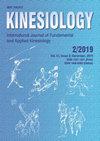Decreased abdominal fat and improved bone metabolism after taekwondo training in obese adolescents
IF 0.9
4区 医学
Q4 REHABILITATION
引用次数: 6
Abstract
Accumulation of abdominal fat during adolescence is associated with early metabolic dysfunctions and interrupting bone metabolism. This study aimed at investigating the effects of taekwondo training on abdominal fat and bone metabolism in obese adolescents. Twenty male obese adolescents, with a body mass index above 95th percentile (BMI: 29.4±1.90 kg/m2), aged 12-15 years, were assigned to the taekwondo training group (TKD, n=11) and control group (CON, n=9). Supervised taekwondo training was performed for 60 minutes/day, three times/week at 60-80% of participants’ heart rate reserve for 16 weeks. Body composition and bone mineral density (BMD) were estimated by dual X-ray absorptiometry. A computerized tomography scan was applied to estimate total abdominal fat (TAF), abdominal visceral fat (AVF), abdominal subcutaneous fat (ASF), and AVF to ASF ratio (VSR). Blood samples were analyzed for adipocytokines (leptin and adiponectin) and bone turnover markers (osteocalcin- OC and C-terminal telopeptide-CTx). There were significant interaction effects between abdominal fat variables and training where TAF (p<.01) and AVF (p<.05) decreased in TKD group. Bone metabolism including bone formation (OC, p<.05) and resorption markers (CTx, p<.05) were significantly increased only in the TKD group. The present study suggests that taekwondo training can be an effective afterschool activity program for providing health benefits including improving abdominal fat and bone metabolism in obese adolescents.Key words: abdominal fat, visceral fat, bone turnover markers, obese adolescent, taekwondo肥胖青少年跆拳道训练后腹部脂肪减少和骨代谢改善
青春期腹部脂肪的积累与早期代谢功能障碍和骨代谢中断有关。本研究旨在探讨跆拳道训练对肥胖青少年腹部脂肪和骨代谢的影响。20名体重指数超过第95百分位(BMI:29.4±1.90 kg/m2)的男性肥胖青少年,年龄12-15岁,被分为跆拳道训练组(TKD,n=11)和对照组(CON,n=9)。监督跆拳道训练每天60分钟,每周三次,持续16周,心率储备为参与者的60-80%。身体成分和骨密度(BMD)通过双X射线吸收法进行估计。应用计算机断层扫描来估计腹部总脂肪(TAF)、腹部内脏脂肪(AVF)、腹腔皮下脂肪(ASF)和AVF/ASF比率(VSR)。分析血液样本中的脂肪细胞因子(瘦素和脂联素)和骨转换标志物(骨钙素-OC和C末端末端肽CTx)。腹部脂肪变量和训练之间存在显著的相互作用,其中TKD组的TAF(p<0.01)和AVF(p<0.05)降低。骨代谢,包括骨形成(OC,p<0.05)和吸收标志物(CTx,p<0.05)仅在TKD组中显著增加。目前的研究表明,跆拳道训练可以成为一种有效的课后活动计划,对健康有益,包括改善肥胖青少年的腹部脂肪和骨代谢。关键词:腹部脂肪、内脏脂肪、骨转换标志物、肥胖青少年、跆拳道
本文章由计算机程序翻译,如有差异,请以英文原文为准。
求助全文
约1分钟内获得全文
求助全文
来源期刊

Kinesiology
REHABILITATION-SPORT SCIENCES
CiteScore
1.90
自引率
8.30%
发文量
16
审稿时长
>12 weeks
期刊介绍:
Kinesiology – International Journal of Fundamental and Applied Kinesiology (print ISSN 1331- 1441, online ISSN 1848-638X) publishes twice a year scientific papers and other written material from kinesiology (a scientific discipline which investigates art and science of human movement; in the meaning and scope close to the idiom “sport sciences”) and other adjacent human sciences focused on sport and exercise, primarily from anthropology (biological and cultural alike), medicine, sociology, psychology, natural sciences and mathematics applied to sport in its broadest sense, history, and others. Contributions of high scientific interest, including also results of theoretical analyses and their practical application in physical education, sport, physical recreation and kinesitherapy, are accepted for publication. The following sections define the scope of the journal: Sport and sports activities, Physical education, Recreation/leisure, Kinesiological anthropology, Training methods, Biology of sport and exercise, Sports medicine and physiology of sport, Biomechanics, History of sport and Book reviews with news.
 求助内容:
求助内容: 应助结果提醒方式:
应助结果提醒方式:


